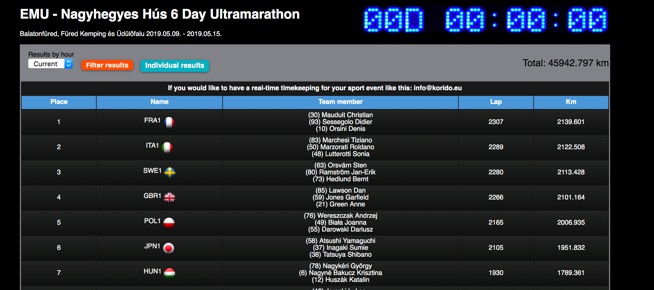EMU 6 day race

The weather wasn't this nice for most of the race.
The race, roughly
Day 1 went fairly well. Due to various injuries I'd done very little running in training and had instead been working on my walking speed. My plan was to walk from the outset, with one running lap every hour for variety. I don't usually sleep on the first night of a multi-day race, but almost everyone else was stopping and I was feeling a bit sleepy so I had a 2 hour sleep. Despite this I managed 79 miles in the first 24 hours. The one big downside was blisters. I knew the Hokas I was having to wear to keep my injured foot happy would blister my feet. However, despite taping the problem spots and preemptively cutting holes in the Hokas, the first blister appeared within hours. By the end of a rainy day I had them all over the sides of my feet, in places that had never ever blistered before and had cut more holes in my shoes. Looking on the bright-side they were less painful, and easier to manage, than my traditional 'ball of feet' blisters.

How to look tall: have your photo taken next to short male
ultra runners, by somebody on a ladder
My knees started aching early on day 2 and my run and walk laps both continued to get slower. I don't remember much about this day, apart from getting a massage. I'm not usually into massages, but after hearing good things about them from other runners I decided to try one. Having my shorts wedged up felt uncomfortable (both physically and mentally) but my legs felt better for it. And it was a good excuse to spend time lying down.
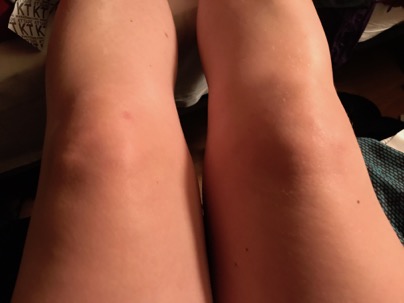
swollen knees (they're usually really knobbly…)
The big problem came on suddenly, in the morning towards the end of 'day' 3 (the race started at midday, so keeping track of days was a bit tricky). My feet felt like they were being squashed in a vice, so I swapped to a pair of cushioned shoes that weren't Hokas. However they weren't cushioned enough and after a couple of hours my foot became painful. So I switched to a new pair of Hokas that I'd got just before the race. They felt wider but I hadn't had time to try them out properly. I was aware that the tongue was rubbing the tendon on the top of my foot and making it sore. But it only became clear how sore when I came to a stop to get a massage and it felt like someone had hit the front of my ankle with a metal pole. And when I took my sock off it was red and swollen. The massage turned into a medical consultation. To my horror there was much tutting and discussion with other people (in Hungarian so I had no idea what was going on). The massage was put on hold and instead I was made to lie with an ice pack on my ankle, and then lotions and potions were rubbed into it.
After the massage I struggled to make it around the circuit back to my bungalow. Every footstep was agony. Re-lacing my shoes so that the tongue didn't touch my foot didn't help. Was this game over? What was I going to do stuck in Hungary for another 3/4 days? I cut the tongue out of my original shoes and tentatively went back out onto the circuit. Walking still hurt, but after 3 days of walking the pain in my leg had, as usual, gone. So how about running? I'd barely done any for a year, but was my shuffle still there? (My shuffle is what my body does when my brain says 'run' 2+ days into a multi-day. It's slower than a run, but somewhat faster than my multi-day walk pace). Initially I just shuffled the longest, slightly downhill straight on the course. But over the course of some (I can't remember how many) hours I worked up to shuffling most of the course, only walking while I ate something from the food tent. To my amazement I wasn't just moving faster, but by alternating shuffling and walking the pain (in my ankle, knees and feet) became manageable.

Butchered shoes
Days 4 and 5 are a bit of a blur. There was a hot afternoon where I struggled to get comfortable and changed kit 3 times. A usually comfortable pair of capris felt like they were taking cheese wire to my crotch. In the end I dug my favourite multi-day tights out of my dirty washing bag and stuck them back on. Normally I'm happy wearing the same dirty, stinky, but comfy, kit for days on end, so why not do the same here? I'm also usually happy to go days without washing properly, but convinced myself that having 2 showers a day was a good idea for minimising chafing issues (possibly it was, but it was mainly an excuse to spent time not run-walking).
I'm usually fairly efficient about sleeping in multi-days, and the bungalow should have been great for sleeping. But the person I was sharing with alternated between heating it up to sauna temperatures and throwing the windows open, with some noisy, smelly 2am cooking thrown in for good measure. Leg pain also hindered sleeping. I'm used to foot pain after 100+ miles, but legs too were a new one. My plan was to sleep for 3-4 hours in the early hours of every morning. But I struggled to keep going into the night, so would usually stop early and then need another post dawn nap.
There were huge variations in how hard keeping going was. Sometimes I flowed around the circuit, effortlessly racking up laps, occasionally singing along to either the music on my phone or what the organisers were playing. Sometimes I made fairly efficient progress by focussing on completing a given number of laps in a fixed time, and only checking the scoreboard in the timing tent at the end of the time. And sometimes every single lap was a battle.
One evening the weather got really stormy. Branches and birds were blown out of trees (the dead bird was quickly removed from the course) and smaller runners got buffeted around. For once I was grateful not to be a skinny runner type. Fighting against the wind actually made me feel stronger. Bring it on, this is nothing on the Spine! Getting back out into it at 4am after a sleep was hard though. I opened the bungalow door and couldn't see a single person on the circuit. So I sent back inside and spent 20 min eating.
On the final night the organisers put jam jars with candles in out around the course. This was initially uplifting, but after a while they blew out and there was still a lot of hours left. At about midnight something really strange and irritating happened. Despite my time-wasting I'd been steadily working my way up the leader board, to mid-20s overall and 6th woman. The 5th placed woman (who earlier in the race had been wearing a tiny pair of hot pants which wouldn't even contain half my bum…) suddenly started marking me. She'd lurk close to me, walk when I walked, run when I ran, and several times cut in front of me, nearly tripping me up. Initially I was amused (no-one has every marked me in a race before!), but after a couple of laps of this nonsense I was thoroughly pissed off. And perplexed. She was 10+km in front of me and moving fairly well. So all she needed to do was keep moving. Eventually I decided to slow down and have a chat to one of the other British runners. After a couple of laps she went into the timing tent and I snuck past her.
I'd vaguely intended to run through the final night, but didn't manage it. When I got going again, my sleep-deprived brain failed to do maths properly and I convinced myself I'd slept away my 350 mile goal. In fact I made it with >3 hours to go. And celebrated by spending half an hour sat in front of a heater trying to warm up. Eventually I pulled on winter tights and a heavy duty rain coat and got back out on the circuit. Initially I was plodding around fairly half-heartedly. Until one of the other British runners told me I could get the longest distance by a British woman in 2019. My initial response was 'no I can't, Sharon Gayter's run 360 miles' (as a training run for her John O'Groats-Lands End record later in the year). But then I did the maths, and if I got back 'running' again it was doable. And I did (361.6 miles), with my final laps being barely slower than my first run lap, back at the end of hour one.
Post-race musings and future plans
I'm generally happy that, despite the pre- and mid-race injuries, I managed to meet my pre-race super-secret (because I was worried that I'd fail absymally to meet it) goal of 350 miles. However if I'd been more efficient, and spent less time concocting excuses to sit on my arse, I could have got closer to my long-term goal of 400 miles. Normally in point-to-point races I'm pretty good at not wasting time. However in a fixed-time race my 'as fast as I comfortably can' mantra doesn't work so well. Not being able to alternate between running and walking on a fixed time rota made things harder mentally. Alternating between running and walking within a single lap actually worked well physically. But I definitely need to find a way to break the race into pieces mentally. Some people were working to very rigid strategies (run/walk for X hours, rest for Y) but I'm not sure whether that would work for me. I also need to come up with tactics for keeping going through bad patches in the absence of my usual "the less you stop/faster you move, the sooner you'll get to place X" tactic. Maybe some (self-inflicted) external pressure might help. So I'll put my goal for next time 'out there' now: 400 miles. Failure due to illness or injury will be acceptable. Failure because I've spent too long sat (or laid) on my arse won't!
I'm not sure about if, and how, a crew would work for me. Having someone to provide food and sort out changes of clothes would make a significant difference. And I suspect that even just having someone there to witness time-wasting would reduce my tendency to do it. However I don't think I'd like the pressure I'd feel from having someone give up a week of their life to look after me. And I'm far too independent/bloody-minded to hand my race strategy over to someone else. The best way to get me to do something is to tell me to do the opposite, or that it's too hard and I shouldn't do it. I'm not sure how that would work in a 6 day race. "Running all day is way too hard, you should sit down, put your feet up and have a nice long break" would be an interesting approach to crewing!
I definitely want to do another 6 day, the question is where and when. Taking to other runners, this is one of the best organised 6 days, however the accommodation in shared bungalows didn't really work for me. I might actually be happier with either a tent of my own or sleeping in a communal hall. I also struggled to get enough calories in. The organisers delivered 2 hot meals a day to the bungalows, but I found the veggie ones hard to eat, so most of my calories came from the (excellent) snack table. Probably the solution here would be to be more self-sufficient with my food.

Yum, not.
Data!
My laptimes paint a fairly accurate picture of my race:
i) too many long breaks…
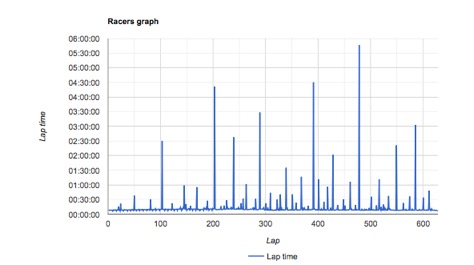
ii) walking and running (downward spikes) laps getting progressively slower during days 1 and 2
iii) injury problems in the 2nd half of day 2
iv) speeding up on day 3 when I deployed my shuffle
v) far, far too many moderate breaks
vi) a finishing kick when given a goal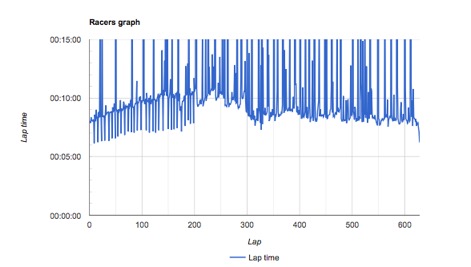
daily milages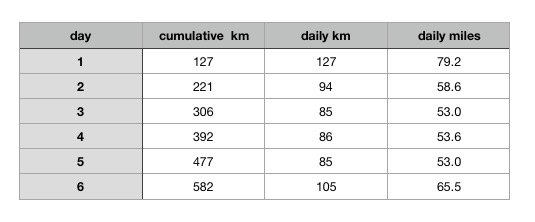
team rankings
(4th in a 4-way battle for the podium, largely due to Dan Lawson's winning run,
we were closer to 1st place than 5th)